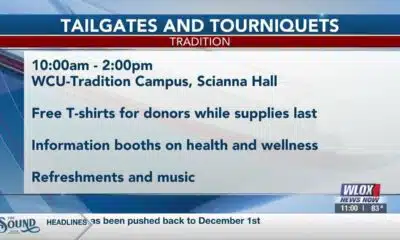News from the South - North Carolina News Feed
More lead testing results back, with good results • Asheville Watchdog
In its first appearance at a Tropical Storm Helene briefing since before Christmas, the Asheville Water Resources Department delivered more good news for customers regarding lead testing results and improving turbidity at North Fork Reservoir.
Spokesperson Clay Chandler said the water system has returned to full corrosion control protection, if it was ever fully lost. Corrosion control helps prevent lead from leaching from private plumbing into tap water.
Chandler said Wednesday the water department has posted 1,200 results for lead testing, and they show 24 tests came back with detectable levels of lead on the first draw of water, and nine of those exceeded the EPA-established action limit of .015 parts per billion.
Of 1,175 “flush samples,” taken after letting the water run, five had detectable levels of lead, three of which were “right at the detection limit,” Chandler said. Two surpassed the EPA-established action level limit.
He said the city identified a couple of issues with those customers, and remediation steps have been taken. The city has said previously that it has no lead in its distribution line piping, but lead can enter taps from private plumbing, particularly in homes built in or before 1988, when lead solder and pipes was banned.
The city announced Nov. 14 that lead had been detected in seven schools after lead mitigation treatments had been suspended 19 days, resuming Oct. 30. The announcement resulted in thousands of customers – about 7,000 total – requesting lead testing kits. No students drank the water during that time frame.
The city restored potable water Nov. 18 and has insisted it is safe to drink.
Health officials emphasize that no level of lead, which can cause development problems in children and has other healthy impacts, is safe.
The lead “detects” in the city system continue to share a commonality, Chandler said, which is that the customers’ water systems “have all been sitting dormant for an extended period.” The city still recommends customers let the water run for 30 seconds before using, or until they notice a temperature change, typically to cooler water.
The city also conducted a resampling of its existing lead and copper sampling pool, sites that are tested every three years as part of compliance with the North Carolina Department of Environmental Quality’s lead awareness program. Of those 51 sampled sites in December, three had a detectable level of lead on the first draw and one was over the action level.
The city sampled the same sites in July, before Helene, and got the same results.
“So that is very good news, because we have comparative sampling data on that sampling pool from over the years, and essentially nothing has changed,” Chandler said. “That’s pretty strong evidence that if corrosion control was ever lost — and there’s not a whole lot of evidence that it was — that it is all the way back. We are obviously very, very happy with that.”
The city previously noted that the lead mitigation program was reinstated Oct. 30 and would take 30 to 90 days to reform the protective coating to prevent lead from leaching into pipes in older homes.
The lead results put the city “still well within the 90th percentile” target required by the EPA and the DEQ. That means at least 90 percent of the first draw samples, if they have detectable lead, must be under the action limit.
“I think we’re actually at like 98.9 percent,” Chandler said.
In early December, two outside experts raised concerns about the lead in city water and recommended more testing.
Chandler said the city has given out about 7,000 test kits and will continue running tests, although he doesn’t expect all of those kits handed out will be tested.
“We don’t think every single one of those is going to come back,” Chandler said. “For example, we’ve had a lot of people ask us to take them off the list as we post results on the website.”
Chandler said lead test kit pickup and drop-off continues to be available from 9 a.m. to 5 p.m., Monday through Friday, at Asheville City Hall, and at three local libraries from 10:30 a.m. to 5 p.m., Tuesday through Saturday. Those branches are the North Asheville Library at 1030 Merrimon Avenue, the East Asheville Library at 3 Avon Road and the West Asheville Library at 942 Haywood Road.
The last day to pick up a test kit from the libraries is Jan. 28, and the last day to drop off at the libraries is Friday, Jan. 31.
“Water Resources strongly encourages our customers who want to lead test kits to pick one up and drop it off before Jan. 31,” Chandler said. “Then our capacity to get test kits to the lab and the results back to the customers is going to be significantly decreased as we return to normal operations.”
Turbidity continues to improve
Chandler also said turbidity continues to improve at North Fork Reservoir, which provides 80 percent of the city’s drinking water, and an Army Corps of Engineers mobile treatment project is operational.
Helene essentially turned North Fork upside down, and turbidity surged in the 350-acre lake. Measured in Nephelometric Turbidity Units (NTUs), turbidity initially stood at 79 NTUs after the storm, resulting in water one city official compared to chocolate milk.
The city restored mostly untreated water to most customers by mid-October, but it had a strong chlorine odor and was discolored, as it was essentially lake water. Clean, potable water returned a month later.
Still, reservoir turbidity remained stubbornly high through much of the fall. As of Dec. 18, it stood at 10.2. On Wednesday, Chandler said it’s down to about 7.
After treatment, turbidity at customers’ taps is extremely low.
“Once that water passes through our filters and our treatment systems, turbidity is around .08, .09, right around there,” Chandler said.
Pre-Helene, turbidity in the raw water at North Fork typically stood around .5, and the city would like to get it back to that level.
“Again, I just don’t think that’s possible with the level of damage that we have in the watershed,” Chandler said, referring to downed trees and muddy washouts.
The city has found that its system can handle higher turbidity than previously thought, but it does require more backwashing and is not a good long-term solution.
The Army Corps of Engineers portable filtration system, which treats higher turbidity water, has helped the city meet demand, which actually has increased since the storm. The Corps contracted the six-month, $39 million project to a private firm.
While tourism has been down drastically since the storm, water usage is up, Chandler said.
“Our average daily demand is right at 25 million gallons a day,” Chandler said. “Before Helene, that number was between 18 and 20 (MGD).”
Chandler did not know what’s driving the increase, although he said some recent breaks of 6- and 8-inch lines due to extreme cold could be a contributing factor.
The city has the capacity to meet demand. North Fork can push out 31 million gallons of treated water a day, and the city’s treatment facility on the Mills River in northern Henderson County another 7 million gallons daily.
“If we had a demand of like 38 million gallons, we could meet it, but we would be redlining our operations,” Chandler said.
Asheville Watchdog is a nonprofit news team producing stories that matter to Asheville and Buncombe County. John Boyle has been covering Asheville and surrounding communities since the 20th century. You can reach him at (828) 337-0941, or via email at jboyle@avlwatchdog.org. The Watchdog’s local reporting during this crisis is made possible by donations from the community. To show your support for this vital public service go to avlwatchdog.org/support-our-publication/.
Related
The post More lead testing results back, with good results • Asheville Watchdog appeared first on avlwatchdog.org
News from the South - North Carolina News Feed
White House officials hold prayer vigil for Charlie Kirk
SUMMARY: Republican lawmakers, conservative leaders, and Trump administration officials held a prayer vigil and memorial at the Kennedy Center honoring slain activist Charlie Kirk, founder of Turning Point USA. Kirk was killed in Utah, where memorials continue at Utah Valley University and Turning Point USA’s headquarters. Police say 22-year-old Tyler Robinson turned himself in but has not confessed or cooperated. Robinson’s roommate, his boyfriend who is transitioning, is cooperating with authorities. Investigators are examining messages Robinson allegedly sent on Discord joking about the shooting. Robinson faces charges including aggravated murder, obstruction of justice, and felony firearm discharge.
White House officials and Republican lawmakers gathered at the Kennedy Center at 6 p.m. to hold a prayer vigil in remembrance of conservative activist Charlie Kirk.
https://abc11.com/us-world/
Download: https://abc11.com/apps/
Like us on Facebook: https://www.facebook.com/ABC11/
Instagram: https://www.instagram.com/abc11_wtvd/
Threads: https://www.threads.net/@abc11_wtvd
TIKTOK: https://www.tiktok.com/@abc11_eyewitnessnews
News from the South - North Carolina News Feed
Family, friends hold candlelight vigil in honor of Giovanni Pelletier
SUMMARY: Family and friends held a candlelight vigil in Apex to honor Giovanni Pelletier, a Fuquay Varina High School graduate whose body was found last month in a Florida retention pond. Giovanni went missing while visiting family, after reportedly acting erratically and leaving his cousins’ car. Loved ones remembered his infectious smile, laughter, and loyal friendship, expressing how deeply he impacted their lives. His mother shared the family’s ongoing grief and search for answers as authorities continue investigating his death. Despite the sadness, the community’s support has provided comfort. A celebration of life mass is planned in Apex to further commemorate Giovanni’s memory.
“It’s good to know how loved someone is in their community.”
More: https://abc11.com/post/giovanni-pelletier-family-friends-hold-candlelight-vigil-honor-wake-teen-found-dead-florida/17811995/
Download: https://abc11.com/apps/
Like us on Facebook: https://www.facebook.com/ABC11/
Instagram: https://www.instagram.com/abc11_wtvd/
Threads: https://www.threads.net/@abc11_wtvd
TIKTOK: https://www.tiktok.com/@abc11_eyewitnessnews
News from the South - North Carolina News Feed
NC Courage wins 2-1 against Angel City FC
SUMMARY: The North Carolina Courage defeated Angel City FC 2-1 in Cary, ending their unbeaten streak. Monaca scored early at the 6th minute, followed by Bull City native Brianna Pinto’s goal at the 18th minute, securing a 2-0 halftime lead. Angel City intensified in the second half, scoring in the 88th minute, but the Courage held firm defensively to claim victory. Pinto expressed pride in the win, emphasizing the team’s unity and playoff ambitions. Nearly 8,000 fans attended. Coverage continues tonight at 11, alongside college football updates, including the Tar Heels vs. Richmond game live from Chapel Hill.
Saturday’s win was crucial for the Courage as the regular season starts to wind down.
https://abc11.com/post/north-carolina-courage-wins-2-1-angel-city-fc/17810234/
Download: https://abc11.com/apps/
Like us on Facebook: https://www.facebook.com/ABC11/
Instagram: https://www.instagram.com/abc11_wtvd/
Threads: https://www.threads.net/@abc11_wtvd
TIKTOK: https://www.tiktok.com/@abc11_eyewitnessnews
-
News from the South - Arkansas News Feed7 days ago
Group in lawsuit say Franklin county prison land was bought before it was inspected
-
News from the South - Kentucky News Feed6 days ago
Lexington man accused of carjacking, firing gun during police chase faces federal firearm charge
-
The Center Square6 days ago
California mother says daughter killed herself after being transitioned by school | California
-
News from the South - Arkansas News Feed6 days ago
Arkansas medical marijuana sales on pace for record year
-
News from the South - Alabama News Feed6 days ago
Zaxby's Player of the Week: Dylan Jackson, Vigor WR
-
Local News Video6 days ago
William Carey University holds 'tailgates and tourniquets' blood drive
-
News from the South - North Carolina News Feed4 days ago
What we know about Charlie Kirk shooting suspect, how he was caught
-
News from the South - Missouri News Feed6 days ago
Local, statewide officials react to Charlie Kirk death after shooting in Utah
















































